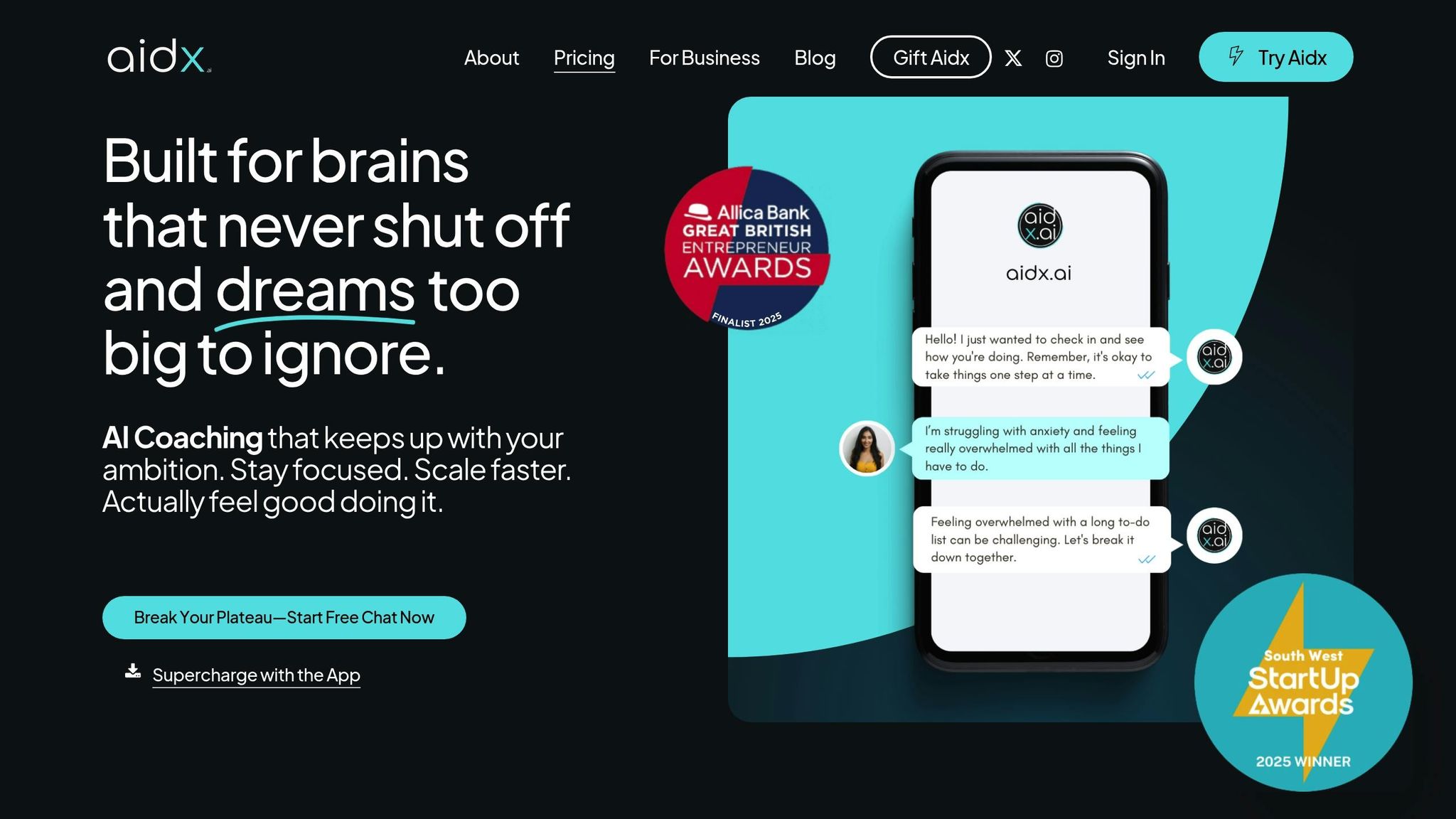Negative thought patterns – like self-criticism or worst-case thinking – affect millions, contributing to anxiety, depression, and even physical health problems. Cognitive Behavioral Therapy (CBT) is a proven method to challenge and change these patterns, but now AI-powered tools are stepping in to make mental health support more accessible and affordable.
Here’s the bottom line:
- CBT offers personalized, face-to-face sessions with therapists, ideal for complex issues but limited by cost, availability, and scheduling.
- AI tools like Aidx.ai provide 24/7, affordable, evidence-based support, with features like voice-enabled interactions and progress tracking, but lack the emotional depth of human therapists.
For mild-to-moderate issues, AI tools can be a convenient option. For severe cases, human therapists remain essential. A hybrid approach – combining both – offers the best of both worlds: continuous AI support for daily challenges and human expertise for deeper emotional needs.
Quick Comparison
| Feature | AI-Powered CBT (e.g., Aidx.ai) | Human CBT Therapy |
|---|---|---|
| Availability | 24/7, immediate | Scheduled sessions only |
| Cost | Subscription-based, lower | $100–$200+ per session |
| Personalization | Algorithm-driven, evolving | Therapist-driven |
| Privacy | Anonymous, encrypted | Varies by provider |
| Human Connection | Limited | Strong emotional depth |
| Best For | Mild-to-moderate issues | Severe or complex cases |
AI tools are reshaping mental health care, but they don’t replace therapists. Instead, they complement them, creating a more flexible and accessible support system for managing negative thoughts.
How CBT Works for Negative Thought Patterns
How CBT Sessions Work
CBT, or Cognitive Behavioral Therapy, typically follows a structured process with clear goals and weekly sessions. One of the first steps involves clients tracking their thoughts, emotions, and triggers to uncover recurring negative patterns that influence their behavior and mindset [4][2].
Therapists use techniques like Socratic questioning and the "Catch It, Check It, Change It" method to help clients examine and reframe negative thoughts. Instead of simply being told their thinking is flawed, clients are guided to reach balanced, more constructive perspectives through thoughtful inquiry. Tools like thought records play a key role, offering a framework to analyze evidence, explore alternative views, and create realistic interpretations of situations [2]. Many sessions also include behavioral activation, where clients are encouraged to engage in enjoyable, mood-boosting activities that promote resilience and well-being [1].
These foundational methods not only demonstrate how CBT works but also provide a baseline for understanding how AI tools are being designed to expand on these principles, offering more accessible and flexible support.
Benefits of CBT
"CBT enhances emotional regulation by challenging negative thought patterns, empowering individuals to develop healthier responses and improve problem-solving, communication, and self-esteem." – Bisma Anwar, Talkspace therapist [3]
CBT brings a range of benefits for managing negative thought patterns. A key advantage is the personalized feedback provided by licensed therapists, who tailor the process to address your unique needs. This approach empowers individuals to take control of their thoughts, challenge negative beliefs, and adopt healthier perspectives. Beyond reframing thoughts, CBT strengthens problem-solving skills, communication, and conflict resolution, which can improve relationships and everyday interactions. By addressing critical self-perceptions, it also helps build self-esteem and equips individuals with long-term strategies for emotional well-being [3].
Studies show that CBT is highly effective, with success rates between 50–75% after completing 5 to 15 sessions for conditions like anxiety and depression [5].
Limitations of CBT
While CBT offers many benefits, it does come with challenges. Cost, limited availability, and the need for consistent scheduling can make it difficult for some to access. Its structured approach may also fall short for individuals dealing with complex or deeply rooted emotional trauma, as it tends to focus more on immediate symptom management rather than underlying issues [5][6][7].
For those with chronic conditions or personality disorders, the typical 12 to 20 sessions [6] might not be enough to achieve lasting results. Additionally, CBT’s emphasis on rational, methodical strategies can feel restrictive for some, especially when deeper emotional healing is needed. Cultural differences in how people process emotions and express themselves may also affect its effectiveness if not properly addressed. Another limitation lies in its reliance on self-reported data, which can sometimes introduce bias. Finally, the success of CBT heavily depends on the strength of the therapeutic relationship; if that connection is weak, the therapy’s outcomes can be significantly diminished [7].
These challenges reveal why AI-driven tools are being explored as a way to complement traditional CBT, addressing some of its limitations while maintaining its core strengths.
AI-Powered CBT Tools: Features and How They Work
How AI-Powered CBT Tools Work
AI-powered CBT tools take traditional cognitive behavioral therapy to a new level by using advanced technology to enhance how interventions are delivered. These tools rely on natural language processing (NLP) to interpret and respond to user input, while algorithms assess emotional tone and customize interventions. They don’t just analyze responses – they adapt guidance and improve through continuous learning.
Many modern tools incorporate generative AI, enabling conversations that feel more natural and adaptive. Research backs this up, showing that generative AI agents significantly outperform older rule-based systems in effectiveness (effect sizes: 1.244 vs. 0.523) [8]. Additionally, many platforms use multimodal interfaces that combine text and voice, ensuring real-time delivery of CBT techniques tailored to each individual’s needs.
Key Features of Aidx.ai

Aidx.ai stands out with its Adaptive Therapeutic Intelligence (ATI) System™, which customizes evidence-based techniques to align with your unique profile. Unlike static tools, the ATI System™ analyzes your emotional state, personal goals, and interaction history to create a therapeutic experience that evolves as you do.
One of its standout features is its voice-enabled interface, making it the first AI mental health and performance coach with a fully developed voice system. This allows for natural, hands-free conversations whether you’re walking, driving, or simply need support on the go. Plus, Aidx.ai is accessible across multiple platforms – web apps, installed apps on most devices, and even Telegram – ensuring support is always within reach.
The platform also bridges the gap between understanding and action. Its integrated planning tools let you set goals, create reminders, track your progress, and receive notifications across various channels. This functionality reinforces CBT’s core focus on actionable insights and self-monitoring. Privacy is a top priority, with full data encryption during transmission and storage, GDPR compliance, and a strict no-human-oversight policy unless legally required. An incognito mode further protects your privacy by automatically deleting session data after 30 minutes, giving you full control over your experience.
Aidx.ai offers specialized modes to cater to different needs. For instance, microcoaching mode provides quick, focused five-minute sessions ideal for busy professionals, while embodiment mode helps users visualize desired future states. Meanwhile, the standard mode offers a comprehensive range of therapeutic methodologies. Together, these features ensure personalized, continuous support, laying the groundwork for 24/7 accessibility.
24/7 Access and Real-Time Support
One of the most game-changing aspects of AI-powered CBT tools is their constant availability. Unlike traditional therapy, which is often restricted to scheduled sessions, these tools provide immediate support whenever challenges arise – whether it’s managing anxiety in the middle of the night or navigating a high-pressure moment at work.
Self-guided modules allow users to engage with CBT techniques at their own pace, making mental health support flexible enough for even the busiest of lifestyles. Real-time feedback further enhances the experience, helping users adjust their approach as they go.
Research highlights the effectiveness of these tools, with studies showing significant reductions in psychological distress (effect size: g = 0.7). Many users report noticeable improvements in symptoms across both clinical and non-clinical groups [8]. This always-available support transforms mental health care from something scheduled into an integral part of daily life, fostering consistent application of CBT principles and quicker progress in managing negative thought patterns.
AI vs CBT: Side-by-Side Comparison
Key Areas of Comparison
When it comes to reshaping negative thought patterns, both AI-powered CBT and traditional CBT bring unique strengths to the table. Let’s break down how they differ in some critical areas.
Accessibility is a major point of distinction. Traditional CBT requires scheduled sessions and depends on the availability of therapists, which can limit access. In contrast, platforms like Aidx.ai are available 24/7, offering immediate support without the need for appointments. This is a game-changer in addressing mental health gaps, especially considering that 293 million people worldwide face mental health challenges, yet only 27% receive standardized care [10].
Personalization is another area where these approaches diverge. Traditional CBT often applies a general framework that may not fit everyone perfectly. On the other hand, AI tools leverage algorithms to tailor treatment based on an individual’s behavior, emotional responses, and progress. For example, Aidx.ai’s Adaptive Therapeutic Intelligence (ATI) System™ evolves with each user, adjusting its guidance in real-time to suit their unique journey.
The stigma factor is also worth noting. Many people avoid therapy due to the fear of judgment or embarrassment. AI-powered tools provide a level of anonymity that can make seeking help less intimidating. Chatbot interactions allow users to open up without the pressure of face-to-face conversations, a barrier that traditional therapy can’t always overcome [10].
Cost is another clear differentiator. Traditional therapy often comes with a hefty price tag, ranging from $100 to $200 or more per session, and may depend on insurance coverage. In comparison, AI-driven CBT tools typically offer subscription-based models that are far more budget-friendly, reducing the financial strain on users [10].
Real-time adaptability is where AI shines. Traditional therapists rely on scheduled appointments and patient self-reports, which can delay interventions. AI tools, however, provide immediate responses by continuously analyzing behavioral patterns, triggers, and stressors. Aidx.ai even offers microcoaching – quick five-minute sessions designed to provide support exactly when it’s needed.
That said, traditional CBT holds an edge in human connection and clinical expertise. The bond between a therapist and patient offers emotional depth and understanding that AI simply can’t replicate. Therapists bring years of training and intuition to navigate complex emotional challenges, making them indispensable for severe mental health issues.
To make things clearer, here’s a direct comparison of the two approaches:
Comparison Table: AI vs CBT
| Dimension | AI-Powered CBT (e.g., Aidx.ai) | Traditional CBT |
|---|---|---|
| Accessibility | 24/7 availability, no appointments, global reach | Limited by schedules, location, and therapist availability |
| Cost | Subscription-based, affordable monthly fees | High costs, often $100–$200+ per session, insurance-dependent |
| Personalization | Adaptive algorithms for real-time customization | Personalized insights, but limited to session data |
| Stigma & Privacy | Anonymous interactions, encrypted for privacy | Face-to-face format may carry stigma; privacy varies |
| Response Time | Immediate interventions | Delayed responses tied to scheduled sessions |
| Consistency | Always delivers evidence-based techniques | Quality varies with therapist expertise and mood |
| Human Connection | Limited emotional nuance | Strong relationships with deep emotional support |
| Complex Cases | Best for standard CBT needs | Better for severe trauma and complex mental health issues |
| Progress Tracking | Continuous via data analytics | Periodic and subjective evaluations by the therapist |
| Engagement | Gamification, reminders, and multi-platform tools | Relies on patient motivation and homework assignments |
Each approach brings something valuable to the table, making it essential to weigh these factors based on individual needs and circumstances. Whether it’s the immediacy and affordability of AI tools or the emotional depth of traditional therapy, the choice depends on what works best for the person seeking help.
Choosing the Right Approach and What’s Next
Factors to Consider When Choosing
Deciding between AI-powered tools and traditional therapy largely depends on the severity of your symptoms and your personal preferences. Research shows that AI tools can reduce anxiety by about 30-35%, while traditional therapy delivers a 45-50% reduction for severe cases like trauma or crises [9]. For mild to moderate issues, AI tools might be a good fit. For more serious conditions, traditional therapy is usually more effective.
If you value personal interaction and empathy, traditional therapy is the way to go. On the other hand, if privacy is a top priority, AI tools provide discreet support with robust privacy features. Financial considerations also play a role – traditional therapy sessions can cost $100 to $200 or more, while AI tools often use subscription models that are more budget-friendly. Plus, AI tools offer 24/7 availability with voice-enabled support across multiple platforms, making them convenient for immediate assistance.
Your learning style and engagement preferences matter too. AI tools excel at delivering structured and consistent approaches, while human therapists offer nuanced, adaptive guidance shaped by years of training and experience. These factors can help you decide which option suits you best – or even explore a combination of both.
The Hybrid Model: Combining AI and Human Support
A hybrid approach blends the strengths of AI tools with human expertise, offering continuous care that adapts to your needs. These hybrid models are gaining popularity as they combine the convenience of AI with the depth of human interaction.
Take Aidx.ai’s Practitioner Mode, for example. It allows therapists to assign tasks and monitor progress between sessions, while users can rely on AI for daily challenges and immediate support. When deeper intervention is necessary, users can seamlessly transition to sessions with their therapist.
This approach provides several benefits. Instead of waiting for weekly appointments, you get round-the-clock care. AI tools can track your progress, predict relapse risks, and provide real-time interventions. Meanwhile, therapists bring their clinical expertise and emotional insight to tackle complex issues. It’s a balanced system – offering the accessibility of AI with the personalized touch of human guidance.
The hybrid model is especially useful for long-term mental health management. AI tools can monitor your ongoing well-being, send reminders for self-care, and identify early signs of negative thought patterns. If concerning changes arise, the system can notify your therapist or encourage you to schedule a session, ensuring you stay on track.
Future Trends in AI and Mental Health
The hybrid model lays the foundation for exciting advancements in mental health care. Generative AI and voice-based interfaces are showing greater promise in reducing psychological distress compared to older, rule-based systems [8]. These tools are becoming better at understanding and responding to emotions in a natural, conversational way.
Adaptive intelligence is another area seeing rapid progress. Future AI systems will offer interventions tailored to your emotional state, goals, and interaction history, delivering a more personalized therapeutic experience. Aidx.ai’s Adaptive Therapeutic Intelligence (ATI) System™ is already leading the way, evolving with each user and adjusting its guidance in real time to match their unique journey.
Predictive capabilities are also advancing. AI tools are improving at identifying relapse risks and monitoring long-term treatment outcomes. This could help address one of the challenges of traditional CBT – relapse after treatment ends [11]. By acting as an early warning system, these tools can help prevent setbacks before they escalate.
Lastly, multi-platform integration is expanding access to mental health support. Future AI tools will work seamlessly across web platforms, mobile apps, messaging services, and smart devices. Voice-enabled interfaces stand out, offering hands-free, natural conversations that feel more intuitive and human-like.
These developments don’t aim to replace therapists but to enhance the overall mental health ecosystem. The goal is to make support more accessible, tailored, and effective for anyone who needs it. The future of mental health care is shaping up to be a collaboration between AI and human expertise, ensuring better outcomes for all.
sbb-itb-d5e73b4
AI therapy is here. What does it mean for you? w/ Dr. Alison Darcy and Brian Chandler
Conclusion: Key Takeaways
Both AI-powered CBT tools and traditional therapy present effective ways to address negative thought patterns, each catering to different levels of need. For more severe symptoms, traditional CBT often achieves a significant reduction (45–50%) through highly personalized care, while AI-powered tools provide accessible, round-the-clock support, showing 30–35% reductions in milder cases [9]. The human touch offered by licensed therapists – particularly during crises or when dealing with complex mental health challenges – remains irreplaceable. These differences highlight the potential of integrating both approaches for more tailored care.
Recent research underscores the effectiveness of generative AI conversational agents, which show a large effect size (g = 1.244) in reducing psychological distress – outperforming retrieval-based systems [8]. A standout in this space is Aidx.ai, leveraging its Adaptive Therapeutic Intelligence (ATI) System™. This system uses evidence-based techniques tailored to each user’s emotional state and interaction history. With a voice-enabled interface and integrated planning features, Aidx.ai helps bridge the gap between gaining insights and taking actionable steps in daily life.
What sets Aidx.ai apart further is its hybrid model. Its Practitioner Mode allows therapists to track user progress and assign tasks, ensuring a seamless transition between AI support and human expertise when needed. This approach demonstrates that choosing between AI-powered CBT and traditional CBT doesn’t have to be an either-or decision. Combining the immediate accessibility of AI, like Aidx.ai, with the depth of human therapy creates a comprehensive solution for managing negative thought patterns – offering a glimpse into the future of mental health care, where technology and human expertise work hand in hand.
FAQs
How does Aidx.ai use AI-powered CBT to help manage negative thoughts more effectively than traditional therapy?
Aidx.ai brings real-time, personalized support to help manage negative thoughts using advanced AI technology. By applying proven methods like Cognitive Behavioral Therapy (CBT), it guides users to identify, challenge, and reshape unhelpful thought patterns right when they occur. Unlike traditional therapy, which depends on scheduled appointments, Aidx.ai is available 24/7, offering immediate assistance during those everyday moments when negative thinking creeps in.
With its voice-enabled interface and Adaptive Therapeutic Intelligence (ATI) System™, Aidx.ai adjusts to your emotional state and remembers past interactions. This allows it to deliver strategies tailored specifically to you, helping to enhance emotional regulation and encourage meaningful, long-term behavioral shifts. It’s an invaluable resource for anyone looking for on-demand support in their journey toward personal growth.
What are the benefits of combining AI tools with traditional CBT for managing mental health?
The Hybrid Power of AI and Traditional CBT
Blending AI tools with traditional Cognitive Behavioral Therapy (CBT) creates a dynamic approach to managing mental health. AI plays a crucial role in making therapy more accessible, especially in areas where mental health resources are limited or during times when face-to-face sessions aren’t an option. It also enables real-time emotional tracking, helping uncover patterns and triggers that might otherwise go unnoticed.
This hybrid approach also allows therapy to be tailored more closely to each individual. AI tools can adjust to specific needs, offering interventions that feel more personalized. Plus, their interactive and engaging design can help maintain consistency and motivation, making them a great complement to the empathy and expertise of human therapists. Together, they pave the way for a more adaptable and effective route to mental well-being.
How do AI tools ensure privacy and help reduce the stigma of seeking mental health support?
AI tools take privacy seriously by integrating encryption, adhering to GDPR standards, and offering features like Incognito Mode, which automatically deletes session data. These safeguards ensure your personal information remains private, giving you greater control over your data while fostering a secure space for self-improvement.
On top of that, AI tools help reduce the stigma surrounding mental health by providing discreet and easily accessible support. With voice-enabled, hands-free options, users can engage in private conversations – whether they’re at home, commuting, or out for a walk. This approach makes seeking help feel more approachable and less daunting, empowering individuals to focus on their mental well-being without the fear of being judged.



